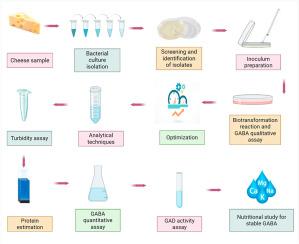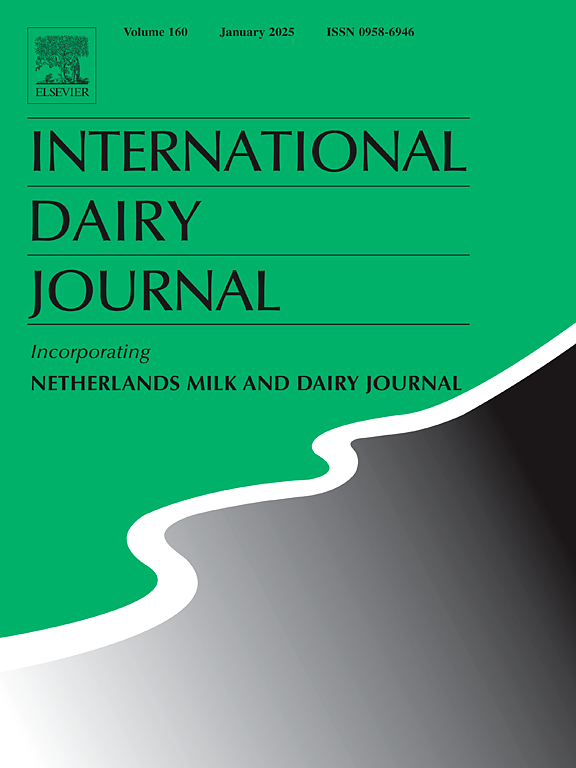从商品奶酪样品中分离的潜在乳酸杆菌释放谷氨酸转化为γ-氨基丁酸的微生物学研究
IF 3.4
3区 农林科学
Q2 FOOD SCIENCE & TECHNOLOGY
引用次数: 0
摘要
本研究利用从废奶酪中分离的菌株研究了谷氨酸转化为γ-氨基丁酸(GABA)的微生物作用。这些废弃奶酪样本是从各种来源收集的,包括拉合尔当地的乳制品店和披萨店,以及巴基斯坦萨希瓦尔工业区。从总共40个细菌分离株中,筛选了14个产生GABA的能力。其中,分离株isl7 (32.7 mM)和isl15 (29.4 mM)在深层发酵条件下GABA产量最高。isl7通过16S rDNA基因扩增鉴定为干酪乳杆菌,isl15通过扫描电镜鉴定为干酪状芽孢杆菌。为了提高GABA的产量,优化了谷氨酸浓度(0.5%)、初始pH(6.5)、孵育时间(48 h)和接种量(8%)等培养条件。研究了菌株的嗜热行为以及酪氨酸、硫胺素、正丁醇和甘油等刺激性化合物对谷氨酸脱羧酶(GAD)活性的影响。35℃时GAD活性最高,其中casamino acid是最有效的刺激剂,在is -7和is -15中分别达到113.1 U/ml和100.4 U/ml。同时评价了微量矿物(MgSO4·7H2O、MnCl2、K2Cr2O7、KI)和宏量矿物(NH4NO3、NaNO3、CaCl2、KH2PO4)对GABA生成的影响。优化后的MgSO4·7H2O (4mm)、KI (0.5 mM)、CaCl2(0.4%)和KH2PO4 (isl7为0.3%,isl15为0.2%)的添加量使GABA产量分别达到244±1.25 mM(25.16±0.13 g/L)和232±1.27 mM(23.91±0.13 g/L)。总体而言,ISL-7和ISL-15的GABA产量分别增加7.46倍和7.89倍(p≤0.05)。将人工神经网络应用于GABA的生产,以建立实验结果与预测结果之间的有效相关性。气相色谱-质谱(GC-MS)分析证实了培养液中GABA的存在。本文章由计算机程序翻译,如有差异,请以英文原文为准。

Exploring microbiological transformation of glutamate to γ-aminobutyric acid unleashed by a potential Lactobacillus spp. isolated from commercial cheese samples
The present study investigated the microbiological transformation of glutamate to γ-aminobutyric acid (GABA) using bacterial strains isolated from waste cheese. The waste cheese samples were collected from various sources, including local dairy shops and pizza outlets in Lahore, as well as from the industrial area of Sahiwal, Pakistan. From a total of 40 bacterial isolates, 14 were screened for their ability to produce GABA. Among them, isolates ISL-7 (32.7 mM) and ISL-15 (29.4 mM) exhibited the highest GABA production under submerged fermentation. ISL-7 was identified as Lacticaseibacillus casei through 16S rDNA gene amplification, while ISL-15 was confirmed as bacillus shaped cheese isolate via scanning electron microscopy. To improve GABA yield, various cultural conditions were optimized, including glutamate concentration (0.5 %), initial pH (6.5), incubation period (48 h), and inoculum size (8 %). The thermophilic behavior of the isolates and the influence of stimulatory compounds such as casamino acid, thiamine HCl, n-butanol, and glycerol on glutamate decarboxylase (GAD) activity were investigated. Maximum GAD activity was recorded at 35 °C, with casamino acid serving as the most effective stimulator, reaching 113.1 U/ml in ISL-7 and 100.4 U/ml in ISL-15. The effects of micro minerals (MgSO4·7H2O, MnCl2, K2Cr2O7, KI) and macro minerals (NH4NO3, NaNO3, CaCl2, KH2PO4) on GABA production were also evaluated. The optimized addition of MgSO4·7H2O (4 mM), KI (0.5 mM), CaCl2 (0.4 %), and KH2PO4 (0.3 % for ISL-7 and 0.2 % for ISL-15) enhanced GABA production to 244 ± 1.25 mM (25.16 ± 0.13 g/L) and 232 ± 1.27 mM (23.91 ± 0.13 g/L) respectively. Overall, GABA production increased 7.46-fold in ISL-7 and 7.89-fold in ISL-15 (p ≤ 0.05). ANN was employed on the GABA production to establish a valid correlation between the experimental and predicted results by the superior isolate of Lactobacillus casei. Gas chromatography–mass spectrometry (GC–MS) analysis validated the presence of GABA in the culture broth.
求助全文
通过发布文献求助,成功后即可免费获取论文全文。
去求助
来源期刊

International Dairy Journal
工程技术-食品科技
CiteScore
6.50
自引率
9.70%
发文量
200
审稿时长
49 days
期刊介绍:
The International Dairy Journal publishes significant advancements in dairy science and technology in the form of research articles and critical reviews that are of relevance to the broader international dairy community. Within this scope, research on the science and technology of milk and dairy products and the nutritional and health aspects of dairy foods are included; the journal pays particular attention to applied research and its interface with the dairy industry.
The journal''s coverage includes the following, where directly applicable to dairy science and technology:
• Chemistry and physico-chemical properties of milk constituents
• Microbiology, food safety, enzymology, biotechnology
• Processing and engineering
• Emulsion science, food structure, and texture
• Raw material quality and effect on relevant products
• Flavour and off-flavour development
• Technological functionality and applications of dairy ingredients
• Sensory and consumer sciences
• Nutrition and substantiation of human health implications of milk components or dairy products
International Dairy Journal does not publish papers related to milk production, animal health and other aspects of on-farm milk production unless there is a clear relationship to dairy technology, human health or final product quality.
 求助内容:
求助内容: 应助结果提醒方式:
应助结果提醒方式:


